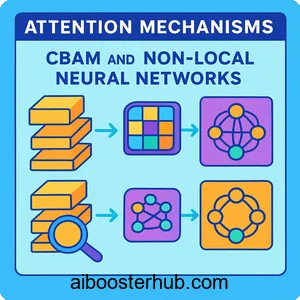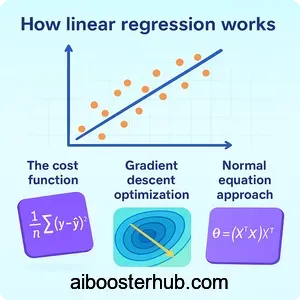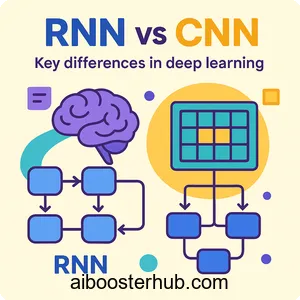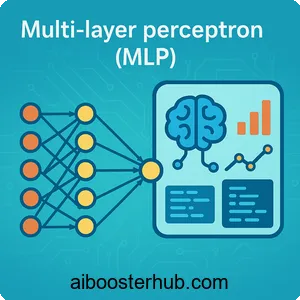Temporal Convolutional Networks for Time Series Analysis
Time series analysis has become increasingly critical in modern AI applications, from weather forecasting to stock market prediction. While recurrent neural network architectures have traditionally dominated this field, a powerful alternative has emerged: temporal convolutional networks (TCN). These specialized neural networks leverage the computational efficiency of convolutional architectures while maintaining the ability to capture long-range temporal dependencies that are essential for accurate time series modeling.
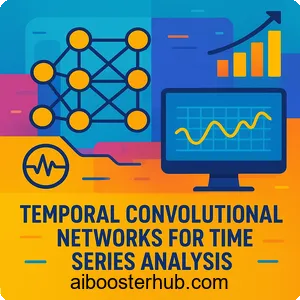
Understanding how temporal convolutional network architectures work and when to apply them can significantly improve your sequence modeling tasks. Whether you’re working on precipitation nowcasting, demand forecasting, or sensor data analysis, TCNs offer compelling advantages in both training speed and prediction accuracy compared to traditional approaches.
Content
Toggle1. Understanding temporal convolutional networks
What makes TCN different from standard convolutions
A temporal convolutional network is a specialized architecture designed specifically for sequence modeling tasks. Unlike standard convolutional neural networks used in image processing, TCN architectures employ causal convolutions that respect the temporal ordering of data. This means the network can only access information from the past and present when making predictions, never from future time steps.
The key innovation in temporal convolutional network design lies in dilated causal convolutions. These operations expand the receptive field exponentially without increasing the number of parameters proportionally. Consider a simple example: with a filter size of 2 and dilation rates that double at each layer (1, 2, 4, 8), a 4-layer TCN can capture dependencies spanning 16 time steps while maintaining computational efficiency.
Architecture components
The fundamental building blocks of time series networks using TCN include:
- Causal convolutions: Ensure predictions at time \( t \) depend only on inputs from times \( \leq t \)
- Dilated convolutions: Increase receptive field exponentially through sparse sampling
- Residual connections: Enable gradient flow through deep networks
- Weight normalization: Stabilize training dynamics
Each residual block in a TCN typically contains two dilated causal convolutional layers with non-linear activation functions and dropout for regularization. The residual connection allows the network to learn identity mappings when needed, making it easier to train very deep architectures.
Mathematical formulation
For a sequence input \( X = (x_1, x_2, …, x_T) \), a dilated causal convolution with dilation factor \( d \) and filter \( f \) of size \( k \) computes:
$$ F(s) = \sum_{i=0}^{k-1} f(i) \cdot x_{s-d \cdot i} $$
where \( s \) is the current time step. The effective receptive field \( R \) for a TCN with \( L \) layers, filter size \( k \), and dilation factors \( d_l = 2^l \) is:
$$ R = 1 + 2 \sum_{l=0}^{L-1} (k-1) \cdot 2^l = 1 + (k-1) \cdot (2^L – 1) $$
This exponential growth allows TCNs to capture very long-range dependencies efficiently.
2. TCN vs recurrent neural network architectures
Performance comparison
The debate between temporal convolutional networks and recurrent neural network models for time series tasks centers on several key dimensions. Traditional RNN variants like LSTM and GRU have been the go-to choice for sequence modeling, but TCNs challenge this dominance with compelling advantages.
Training parallelization represents one of the most significant benefits of TCN. While recurrent neural networks must process sequences sequentially due to their hidden state dependencies, temporal convolutional network architectures can process all time steps in parallel during training. This leads to dramatic speedups, especially for long sequences.
Consider a weather forecasting task with 1000 time steps: a recurrent neural network requires 1000 sequential forward passes during training, whereas a TCN can process the entire sequence in a single parallelized forward pass. This difference becomes even more pronounced with modern GPU architectures optimized for parallel computation.
Memory and gradient flow
The vanishing gradient problem has long plagued recurrent neural network training, even with gating mechanisms in LSTM networks. TCNs sidestep this issue through their residual connections and bounded gradient paths. The gradient flow in a TCN follows clear, direct paths through the network, similar to ResNet architectures in computer vision.
For a concrete comparison, let’s look at memory complexity:
- RNN: \( O(n \cdot h) \) where \( n \) is sequence length and \( h \) is hidden size
- TCN: \( O(n \cdot c \cdot k) \) where \( c \) is number of channels and \( k \) is filter size
While TCNs may use more memory during training due to storing activations at multiple dilation levels, inference memory requirements can be lower since no hidden states need to be maintained between predictions.
When to choose TCN over RNN
Temporal convolutional network architectures excel in scenarios where:
- Long sequences are common: The parallel processing capability makes TCN significantly faster for sequences with hundreds or thousands of time steps
- Fixed receptive field is acceptable: When you know approximately how far back in history the model needs to look
- Training speed matters: Projects with tight iteration cycles benefit from faster training
- Stability is crucial: Production systems requiring reliable convergence
However, recurrent neural networks may still be preferable when:
- Sequence lengths vary dramatically and unpredictably
- Theoretical guarantees about infinite memory are important
- The task requires maintaining explicit state between predictions
3. Implementing TCN in Python
Basic TCN architecture
Let’s build a temporal convolutional network from scratch using PyTorch. This implementation will demonstrate the core concepts clearly:
import torch
import torch.nn as nn
from torch.nn.utils import weight_norm
class CausalConv1d(nn.Module):
def __init__(self, in_channels, out_channels, kernel_size, dilation=1):
super(CausalConv1d, self).__init__()
self.padding = (kernel_size - 1) * dilation
self.conv = weight_norm(nn.Conv1d(
in_channels, out_channels, kernel_size,
padding=self.padding, dilation=dilation
))
def forward(self, x):
# Apply convolution and remove future information
x = self.conv(x)
return x[:, :, :-self.padding] if self.padding != 0 else x
class TCNBlock(nn.Module):
def __init__(self, in_channels, out_channels, kernel_size, dilation, dropout=0.2):
super(TCNBlock, self).__init__()
self.conv1 = CausalConv1d(in_channels, out_channels, kernel_size, dilation)
self.relu1 = nn.ReLU()
self.dropout1 = nn.Dropout(dropout)
self.conv2 = CausalConv1d(out_channels, out_channels, kernel_size, dilation)
self.relu2 = nn.ReLU()
self.dropout2 = nn.Dropout(dropout)
# Residual connection
self.downsample = nn.Conv1d(in_channels, out_channels, 1) if in_channels != out_channels else None
self.relu = nn.ReLU()
def forward(self, x):
out = self.conv1(x)
out = self.relu1(out)
out = self.dropout1(out)
out = self.conv2(out)
out = self.relu2(out)
out = self.dropout2(out)
res = x if self.downsample is None else self.downsample(x)
return self.relu(out + res)
class TemporalConvNet(nn.Module):
def __init__(self, num_inputs, num_channels, kernel_size=2, dropout=0.2):
super(TemporalConvNet, self).__init__()
layers = []
num_levels = len(num_channels)
for i in range(num_levels):
dilation_size = 2 ** i
in_channels = num_inputs if i == 0 else num_channels[i-1]
out_channels = num_channels[i]
layers.append(TCNBlock(
in_channels, out_channels, kernel_size,
dilation_size, dropout
))
self.network = nn.Sequential(*layers)
def forward(self, x):
return self.network(x)
Complete time series forecasting model
Now let’s create a complete model for time series prediction:
class TCNForecaster(nn.Module):
def __init__(self, input_size, output_size, num_channels, kernel_size=2, dropout=0.2):
super(TCNForecaster, self).__init__()
self.tcn = TemporalConvNet(input_size, num_channels, kernel_size, dropout)
self.linear = nn.Linear(num_channels[-1], output_size)
def forward(self, x):
# x shape: (batch_size, input_size, sequence_length)
y = self.tcn(x)
# Take the last time step
y = y[:, :, -1]
return self.linear(y)
# Example usage
def train_tcn_model():
# Hyperparameters
input_size = 10 # Number of input features
output_size = 1 # Predicting single value
num_channels = [32, 32, 64, 64] # Channel sizes for each TCN level
kernel_size = 3
dropout = 0.2
# Initialize model
model = TCNForecaster(input_size, output_size, num_channels, kernel_size, dropout)
# Example: Generate synthetic data
batch_size = 32
sequence_length = 100
x = torch.randn(batch_size, input_size, sequence_length)
y = torch.randn(batch_size, output_size)
# Training setup
criterion = nn.MSELoss()
optimizer = torch.optim.Adam(model.parameters(), lr=0.001)
# Single training step
model.train()
optimizer.zero_grad()
output = model(x)
loss = criterion(output, y)
loss.backward()
optimizer.step()
return model, loss.item()
# Run example
model, loss = train_tcn_model()
print(f"Training loss: {loss:.4f}")
Practical tips for implementation
When implementing temporal convolutional network architectures, consider these optimization strategies:
Receptive field calculation: Choose the number of layers and dilation factors to ensure your receptive field covers the relevant history. For a problem requiring 200 time steps of context with kernel size 3, you’d need approximately \( \log_2(200/2) \approx 7 \) layers with exponentially increasing dilation.
Channel progression: Gradually increase channel counts in deeper layers (e.g., [25, 50, 100, 200]) to capture increasingly complex temporal patterns while managing computational cost.
Regularization: Dropout rates between 0.1 and 0.3 work well for most time series tasks. Higher dropout may be needed for smaller datasets.
4. Advanced applications in time series
Convolutional LSTM network a machine learning approach for precipitation nowcasting
One of the most compelling applications of combining temporal convolutional network concepts with recurrent architectures is precipitation nowcasting. The convolutional LSTM network a machine learning approach for precipitation nowcasting demonstrates how hybrid architectures can leverage the best of both worlds.
Precipitation nowcasting requires capturing both spatial patterns in radar images and temporal dynamics of weather systems. A pure TCN can handle the temporal dimension effectively, but combining it with convolutional structures for spatial processing creates a powerful ensemble. This approach has shown remarkable success in predicting rainfall intensity and location minutes to hours in advance.
The key insight from the convolutional LSTM network a machine learning approach for precipitation nowcasting is that different architectural components excel at different aspects of the problem:
- Spatial convolutions: Extract features from radar imagery
- Temporal convolutions (TCN): Model atmospheric dynamics over time
- LSTM components: Maintain state for irregularly arriving data
Multi-horizon forecasting
Temporal convolutional networks excel at multi-horizon forecasting where you need to predict multiple future time steps simultaneously. Unlike auto-regressive recurrent neural network approaches that predict one step at a time, TCNs can be trained to output entire future sequences directly.
class MultiHorizonTCN(nn.Module):
def __init__(self, input_size, forecast_horizon, num_channels, kernel_size=2):
super(MultiHorizonTCN, self).__init__()
self.tcn = TemporalConvNet(input_size, num_channels, kernel_size)
self.forecast_horizon = forecast_horizon
# Separate output head for each forecast step
self.output_layers = nn.ModuleList([
nn.Linear(num_channels[-1], 1) for _ in range(forecast_horizon)
])
def forward(self, x):
# x shape: (batch_size, input_size, sequence_length)
features = self.tcn(x)
last_features = features[:, :, -1] # (batch_size, channels)
# Generate predictions for all horizons
predictions = [layer(last_features) for layer in self.output_layers]
return torch.cat(predictions, dim=1) # (batch_size, forecast_horizon)
# Example: Forecasting next 24 hours
model = MultiHorizonTCN(
input_size=10,
forecast_horizon=24,
num_channels=[32, 64, 128, 128]
)
# Input: 168 hours (1 week) of history
x = torch.randn(16, 10, 168) # batch_size=16
predictions = model(x) # Shape: (16, 24)
Anomaly detection with TCN
Time series networks using TCN architecture are particularly effective for anomaly detection in streaming data. The autoencoder variant learns to reconstruct normal patterns, and reconstruction errors signal anomalies.
class TCNAutoencoder(nn.Module):
def __init__(self, input_size, encoding_channels, kernel_size=3):
super(TCNAutoencoder, self).__init__()
# Encoder: compress temporal patterns
self.encoder = TemporalConvNet(
input_size, encoding_channels, kernel_size, dropout=0.1
)
# Decoder: reconstruct original sequence
decoder_channels = encoding_channels[::-1][1:] + [input_size]
self.decoder = TemporalConvNet(
encoding_channels[-1], decoder_channels, kernel_size, dropout=0.1
)
def forward(self, x):
encoded = self.encoder(x)
reconstructed = self.decoder(encoded)
return reconstructed
def detect_anomalies(self, x, threshold):
self.eval()
with torch.no_grad():
reconstructed = self.forward(x)
# Calculate reconstruction error
error = torch.mean((x - reconstructed) ** 2, dim=[1, 2])
anomalies = error > threshold
return anomalies, error
# Example usage for sensor monitoring
model = TCNAutoencoder(
input_size=5, # 5 sensor readings
encoding_channels=[16, 32, 64],
kernel_size=3
)
# Normal training data
normal_data = torch.randn(100, 5, 200) # 100 normal sequences
criterion = nn.MSELoss()
optimizer = torch.optim.Adam(model.parameters(), lr=0.001)
# Training loop (simplified)
model.train()
for epoch in range(50):
optimizer.zero_grad()
reconstructed = model(normal_data)
loss = criterion(reconstructed, normal_data)
loss.backward()
optimizer.step()
# Detect anomalies in new data
test_data = torch.randn(20, 5, 200) # 20 test sequences
anomalies, errors = model.detect_anomalies(test_data, threshold=0.5)
print(f"Detected {anomalies.sum().item()} anomalies")
5. Optimizing TCN performance
Hyperparameter tuning strategies
Optimizing temporal convolutional network architectures requires careful attention to several key hyperparameters that significantly impact both training efficiency and prediction accuracy.
Receptive field sizing is the most critical decision. Calculate the minimum receptive field needed for your task using the formula:
$$ R_{\text{min}} = \text{max_lag} + \text{prediction_horizon} $$
Then design your network to exceed this slightly. For example, if your time series exhibits seasonality every 50 time steps and you’re predicting 10 steps ahead, target a receptive field of at least 60 time steps.
Filter size and dilation strategy work together to achieve your target receptive field. Common patterns include:
- Conservative: kernel size 2, dilations [1, 2, 4, 8, 16, 32]
- Aggressive: kernel size 5, dilations [1, 2, 4, 8]
- Balanced: kernel size 3, dilations [1, 2, 4, 8, 16]
The aggressive approach captures longer dependencies with fewer layers but uses more parameters per layer. The conservative approach provides finer-grained control with more layers.
Handling variable-length sequences
While TCNs naturally work with fixed-length inputs, many real-world time series datasets contain sequences of varying lengths. Here are effective strategies:
class AdaptiveTCN(nn.Module):
def __init__(self, input_size, num_channels, kernel_size=3):
super(AdaptiveTCN, self).__init__()
self.tcn = TemporalConvNet(input_size, num_channels, kernel_size)
self.adaptive_pool = nn.AdaptiveAvgPool1d(1)
self.output = nn.Linear(num_channels[-1], 1)
def forward(self, x, lengths=None):
# x: (batch_size, input_size, max_sequence_length)
features = self.tcn(x)
if lengths is not None:
# Mask out padding positions
mask = torch.arange(x.size(2)).expand(x.size(0), -1) < lengths.unsqueeze(1)
mask = mask.unsqueeze(1).float().to(x.device)
features = features * mask
# Global pooling across time dimension
pooled = self.adaptive_pool(features).squeeze(-1)
return self.output(pooled)
# Example with variable lengths
batch_size = 4
sequences = [
torch.randn(1, 10, 50), # length 50
torch.randn(1, 10, 75), # length 75
torch.randn(1, 10, 100), # length 100
torch.randn(1, 10, 60), # length 60
]
# Pad to maximum length
max_len = max(seq.size(2) for seq in sequences)
padded_sequences = [
torch.nn.functional.pad(seq, (0, max_len - seq.size(2)))
for seq in sequences
]
x = torch.cat(padded_sequences, dim=0)
lengths = torch.tensor([50, 75, 100, 60])
model = AdaptiveTCN(input_size=10, num_channels=[32, 64, 128])
output = model(x, lengths)
Transfer learning with pre-trained TCN
Transfer learning can accelerate training when you have related time series tasks. Pre-train on a large dataset, then fine-tune on your specific problem:
def pretrain_tcn(model, large_dataset, epochs=100):
"""Pre-train TCN on large related dataset"""
optimizer = torch.optim.Adam(model.parameters(), lr=0.001)
criterion = nn.MSELoss()
model.train()
for epoch in range(epochs):
total_loss = 0
for x_batch, y_batch in large_dataset:
optimizer.zero_grad()
predictions = model(x_batch)
loss = criterion(predictions, y_batch)
loss.backward()
optimizer.step()
total_loss += loss.item()
if (epoch + 1) % 10 == 0:
print(f"Epoch {epoch+1}, Loss: {total_loss/len(large_dataset):.4f}")
return model
def finetune_tcn(pretrained_model, target_dataset, epochs=20, freeze_layers=2):
"""Fine-tune pre-trained TCN on specific task"""
# Freeze early layers
for i, block in enumerate(pretrained_model.tcn.network):
if i < freeze_layers:
for param in block.parameters():
param.requires_grad = False
# Use smaller learning rate for fine-tuning
optimizer = torch.optim.Adam(
filter(lambda p: p.requires_grad, pretrained_model.parameters()),
lr=0.0001
)
criterion = nn.MSELoss()
pretrained_model.train()
for epoch in range(epochs):
for x_batch, y_batch in target_dataset:
optimizer.zero_grad()
predictions = pretrained_model(x_batch)
loss = criterion(predictions, y_batch)
loss.backward()
optimizer.step()
return pretrained_model
6. Comparing TCN with other sequence modeling approaches
Benchmarking against transformer architectures
The rise of transformer architectures in natural language processing has sparked interest in their application to time series. How do temporal convolutional networks compare with transformers for sequence modeling tasks?
Transformers excel at capturing global dependencies through self-attention mechanisms, but this comes at a computational cost of \( O(n^2) \) where \( n \) is sequence length. For very long time series (thousands of time steps), this quadratic complexity becomes prohibitive. TCN maintains \( O(n) \) complexity through its convolutional structure.
Consider a comparison on a financial forecasting task with 1000 time steps:
TCN advantages:
- Training time: 2-3x faster than transformers
- Memory usage: Scales linearly with sequence length
- Interpretability: Clear hierarchical feature extraction
- Stability: Fewer hyperparameters to tune
Transformer advantages:
- Attention weights provide explicit explanations
- Better at capturing irregular temporal patterns
- More effective for sequences with strong position-independent relationships
Hybrid architectures
The most powerful approaches often combine multiple paradigms. Several successful hybrid designs merge temporal convolutional network concepts with other architectures:
class TCNTransformer(nn.Module):
def __init__(self, input_size, tcn_channels, nhead=4, num_layers=2):
super(TCNTransformer, self).__init__()
# TCN for initial feature extraction
self.tcn = TemporalConvNet(input_size, tcn_channels, kernel_size=3)
# Transformer for global dependencies
self.pos_encoder = nn.Parameter(torch.randn(1, 1000, tcn_channels[-1]))
encoder_layer = nn.TransformerEncoderLayer(
d_model=tcn_channels[-1],
nhead=nhead,
dim_feedforward=tcn_channels[-1] * 4,
batch_first=True
)
self.transformer = nn.TransformerEncoder(encoder_layer, num_layers)
self.output = nn.Linear(tcn_channels[-1], 1)
def forward(self, x):
# x: (batch_size, input_size, seq_len)
# Extract local temporal features with TCN
tcn_features = self.tcn(x) # (batch_size, channels, seq_len)
# Transpose for transformer
tcn_features = tcn_features.transpose(1, 2) # (batch_size, seq_len, channels)
# Add positional encoding
seq_len = tcn_features.size(1)
tcn_features = tcn_features + self.pos_encoder[:, :seq_len, :]
# Apply transformer for global patterns
transformer_out = self.transformer(tcn_features)
# Use last time step for prediction
return self.output(transformer_out[:, -1, :])
# Example usage
model = TCNTransformer(
input_size=10,
tcn_channels=[32, 64, 128],
nhead=4,
num_layers=2
)
x = torch.randn(8, 10, 200)
output = model(x)
print(f"Output shape: {output.shape}") # (8, 1)
This hybrid approach uses TCN for efficient local pattern extraction and transformers for modeling long-range dependencies where they’re most valuable.
Performance metrics and evaluation
When comparing different sequence modeling architectures, consider multiple evaluation dimensions beyond just prediction accuracy:
Forecasting accuracy metrics:
- Mean Absolute Error (MAE): \( \frac{1}{n}\sum_{i=1}^{n}|y_i – \hat{y}_i| \)
- Root Mean Squared Error (RMSE): \( \sqrt{\frac{1}{n}\sum_{i=1}^{n}(y_i – \hat{y}_i)^2} \)
- Mean Absolute Percentage Error (MAPE): \( \frac{100%}{n}\sum_{i=1}^{n}|\frac{y_i – \hat{y}_i}{y_i}| \)
Computational efficiency:
- Training time per epoch
- Inference latency (critical for real-time applications)
- Memory footprint during training and inference
- Parameter count and model size
Practical considerations:
- Convergence stability across random seeds
- Sensitivity to hyperparameter choices
- Ease of debugging and troubleshooting
- Deployment complexity
In practice, temporal convolutional networks often provide the best balance of these factors for time series tasks, especially when dealing with long sequences and requiring fast training iterations.
7. Best practices and future directions
Production deployment considerations
Deploying temporal convolutional network models in production environments requires attention to several practical aspects that go beyond model accuracy.
Model serving optimization: TCN architectures are naturally suited for efficient inference. Unlike recurrent neural networks that maintain hidden states, TCN models are stateless, making them easier to scale horizontally. Consider using ONNX or TorchScript for optimized deployment:
import torch
def export_tcn_for_production(model, example_input, filepath):
"""Export TCN model for production deployment"""
model.eval()
# Trace the model
traced_model = torch.jit.trace(model, example_input)
# Optimize for inference
traced_model = torch.jit.optimize_for_inference(traced_model)
# Save
traced_model.save(filepath)
return traced_model
# Example
model = TCNForecaster(input_size=10, output_size=1, num_channels=[32, 64])
example_input = torch.randn(1, 10, 100)
export_tcn_for_production(model, example_input, "tcn_model.pt")
# Load and use in production
loaded_model = torch.jit.load("tcn_model.pt")
loaded_model.eval()
prediction = loaded_model(example_input)
Monitoring and retraining: Time series distributions often drift over time. Implement continuous monitoring of prediction errors and automatic retraining pipelines. Set up alerts when model performance degrades beyond acceptable thresholds.
Handling edge cases: Production time series networks must gracefully handle missing values, outliers, and unexpected input distributions. Build robust preprocessing pipelines that normalize data consistently between training and inference.
Research frontiers
The field of temporal convolutional networks continues to evolve rapidly. Several promising research directions are expanding the capabilities of TCN architectures:
Neural architecture search for TCN: Automated methods for discovering optimal TCN configurations (dilation patterns, channel counts, depth) specific to your dataset can outperform hand-crafted designs. This is particularly valuable when you have sufficient computational resources for hyperparameter optimization.
Probabilistic TCN models: Extending TCN to output full predictive distributions rather than point estimates enables better uncertainty quantification. This is crucial for decision-making in high-stakes domains like healthcare or finance.
Multi-modal TCN: Combining temporal convolutional networks with other data modalities (text, images, graphs) opens new possibilities. For example, using TCN for time series alongside graph neural networks for spatial relationships in traffic forecasting.
Continual learning: Developing TCN variants that can learn from streaming data without catastrophic forgetting represents an important frontier for adaptive systems that must evolve with changing environments.
The integration of concepts from the convolutional LSTM network a machine learning approach for precipitation nowcasting and similar hybrid architectures suggests that the future lies not in pure TCN or pure recurrent neural network approaches, but in thoughtfully designed combinations that leverage the strengths of multiple paradigms.
8. Conclusion
Temporal convolutional networks represent a powerful and efficient approach to time series analysis that challenges the traditional dominance of recurrent neural network architectures. Through dilated causal convolutions and residual connections, TCN achieves the ability to capture long-range temporal dependencies while maintaining the computational efficiency and training stability that make them practical for real-world applications.
The versatility of temporal convolutional network architectures spans from simple forecasting tasks to complex applications like precipitation nowcasting and anomaly detection. Whether you’re building production time series networks or exploring cutting-edge research, understanding TCN provides you with a valuable tool that often outperforms traditional approaches in both accuracy and efficiency. As the field continues to evolve, the principles underlying TCN—parallel processing, hierarchical feature extraction, and stable gradient flow—will remain fundamental to advancing sequence modeling capabilities.




